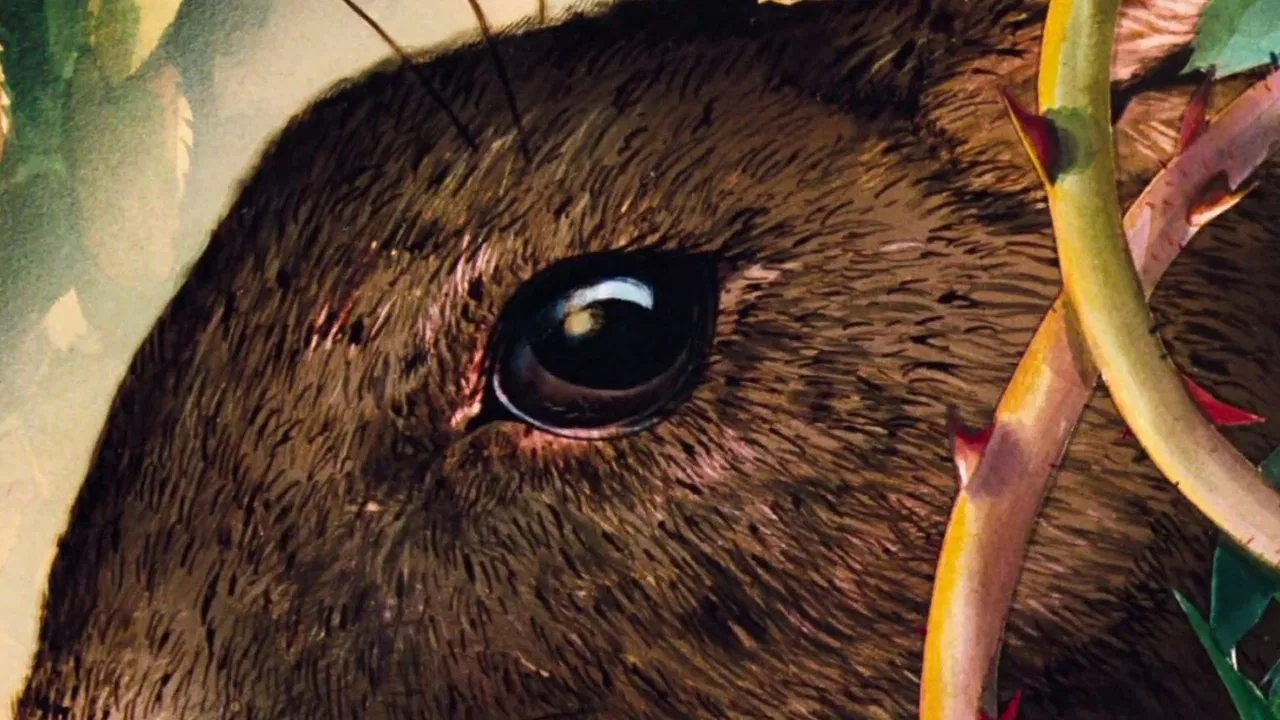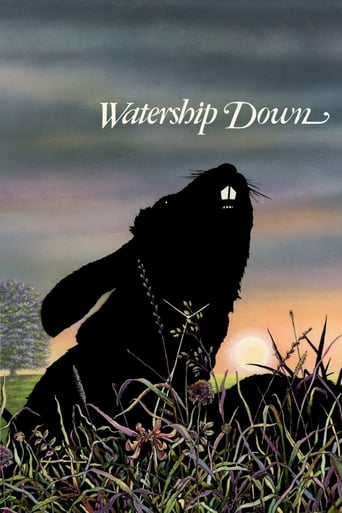

I was quite young when I watched this movie. The scenes terrified me so much and I had nightmares for weeks. Everytime I come to watch this movie it terrifies me still and I have to turn it off.
... View MoreRichard Adams' beloved novel about a ragtag group of rabbits who escape from their doomed warren to find a new home was given the animated treatment and was a massive success round the world. With memorable characters, an adventurous narrative, a beautiful score and breathtaking visuals all combine to a wonderful animation masterpiece.The film boasts an illustrious voice cast of England's top talents particularly in the late Sir John Hurt as Hazel, the troupe's self-appointed leader, the late Richard Briers as Hazel's psychic brother, Fiver, Harry Andrews as the evil General Woundwort and in a final performance that leaves an impact is legendary comedian Zero Mostel as the sour, snarky and helpful gull Kehaar. John Hurt's Hazel is clever, soft=-spoken, at times naive but a strong leader who earns his status as the group's Chief (the head of a rabbit warren in the novel's universe). Brier's Fiver is timid, cautious, smart (thanks in small part to his psychic abilities) and loyal to his brother and the group. Andrews' Woundwort is a vicious and terrifying villain who will rip any insubordinate member of his Efrafa warren to shreds if they defy him. And Zero Mostel as Kehaar is funny as his character spouts lines with an accent that sounds like vaguely Germanic, but laced with hilarity.The narrative structure is faithful to the source material as it follows the characters' struggles to find their home to their battle with the Efrafans. The story never loses its resonance even after nearly 40 years as the impact is still felt and the story is continuously shared by all generations.
... View MoreThere is an unfortunate aspect that must come with the visual medium, and this is that the rabbit's point of view switches to a more omnipotent one. Richard Adams' classic novel had a way of characterising the rabbit's perspective within their own worldview and terms. His descriptions of how they saw strange and alien threats such as bulldozers, cars and roads are brilliant, offering just enough hint of form to the human reader for us to understand and comprehend how terrifying it must be to have a metal creature rip up the earth itself. In particular there is a wonderful sequence missing, entailing how Holly recounts a roaring train as some sort of godly presence sent by El-ahrairah himself to save the rabbits from the Efrafan patrol. We don't get this in a movie, of course. A car is just a car, a road just a road, and when Hazel is shot, we already know what must be done long before Kehaar chimes in. Adams created an entire lore from the rabbits' worldview and some remnants of it remain, thankfully. Hubley's lasting presence is felt mostly in the opening sequence, a bouncy, cartoony style creation story tinged with cultural importance and ethnocentrism. It's charming and fluffy, as if it was being told by a mother rabbit to its kittens right before bedtime, and it also provides the valuable aspect of juxtaposition to the film's real world and its harsher environment and animation style. This has always been a point of contention when discussing the film, of how it smuggles in its graphic violence amidst the initial presentation and premise. A animated story about fluffy bunnies is perfectly appropriate, reasoned parents of unassuming children. But this is precisely why Adams' story is so valuable. It strips away those innocent notions of animals and the wild. It doesn't sanitise what it must be like to survive beyond the comfort of the rabbit hutch.Is it a good adaption? Well, yes and no. Some of the images it manages to capture defy what any written description could ever achieve. The animation style has the backgrounds painted in lush, delicate watercolours, and then the rabbits drawn with hard-edged lines. This allows for the animators to easily tinge the colour palette; purple and yellow for sunset, or drenching the fields with blood-red in Fiver's visions. The uneasiness surrounding the Cowslip's warren is illustrated in colour instead - their warren's tunnels are coloured unnaturally, in bright and lurid oranges and pinks to signify the inhabitant's departure from the natural wilderness rabbit life. Holly's recount has a thick air of terror imbued within, and the animation swirls like a hallucinatory nightmare as he re-experiences the invasion and destruction of man. The soundtrack also lends an extra element to the film. When the group's only doe, Violet, is snatched up in the blink of an eye by an eagle, the score screeches in anguish, almost alive. And who could ever forget Art Garfunkel's Bright Eyes in the moving sequence where a vision of the Black Rabbit leads Fiver to his injured brother. Unfortunately, these seem like cosmetic improvements that distract from what has been taken from the heart of the story. Animation is expected to be a lengthy and costly process, so the basic plot points have been retained here, but a more than cursory glance reveals that much is missing. The film is a compressed, condensed version of the events on Watership Down. It skips the leadership and decision making process that gradually sees a meek rabbit evolve into Hazel-Rah. Case in point: Hazel doesn't make the decision for the whole group to feed and nurse Kehaar for no immediate benefit, he just decides to help them for no reason. There is no process of trial and error that sees Hazel learn from his mistakes, or see his initial decisions benefit them in the long run (like befriended the mouse). A brilliant line from the novel is turned into something far less meaningful - it is supposed to signify Bigwig's shift in demeanour over time to accept Hazel's authority, but here it's just used to emphasise Woundwort's short-sightedness by repeated highlighting how much he wants to rip 'Chief Rabbit' Bigwig into shreds. And Woundwort himself is turned into some tame bedtime story legend, instead of a lasting remnant of the strange powers of brainwashing and devotion. Where is Dandelion's speed and storytelling? Blackberry's intelligence? Hazel was wise enough to respect and utilise those around him, but here the secondary characters are pushed back. Hazel is the real hero, but we don't feel the protectiveness and love he has for his warren, so his death isn't nearly as moving as it should have been.
... View MoreWhen i was younger this film is scared me when i was an little kid, so later in few years i watch again and it i have an strange feeling that it's was good like this film.it was make this film is happy (The scene of fly scene of Kehaar and even his humor), scared (the fighting of heroes against villains) and even sadness (the main protagonist Hazel is going with Black Rabbit Of Inlé to Frith).Which it was an great film to follow the book of the same name, and plus the music named "Bright Eyes" by Mike Batt which it was one of the beautiful and sadness music i have ever heard.Final Rating: 9 out of 10
... View More